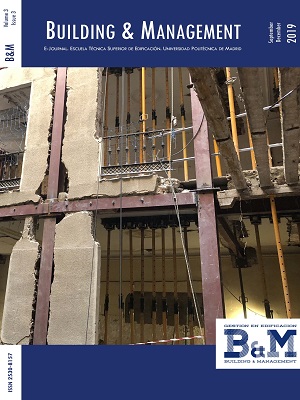Distance & Light Intensity Smart Lamp = Distancia e intensidad de luz de lampara inteligente
DOI:
https://doi.org/10.20868/bma.2019.3.4031Palabras clave:
LED, Optimization, Distance & Illumination, Fritzing, ArduinoResumen
Abstract
This work proposes an electronic system which, adapted to a LED lamp, optimizes the use of electrical energy, improves lighting comfort, etc. All this is possible with the programming of an Ultrasonic Distance Sensor (#28015) through an Arduino Nano Rev. 3. This Arduino, connected to actuators, regulates the intensity of the light depending on the distance between the lamp and the work area. In case an object or a human being approaches or moves away from the lamp, the luminous intensity will increase or decrease in relation to the previously established parameters. In order to achieve this objective, the installation of a breadboard of the proposed system is carried out for its subsequent testing and simulation. Several open source software are also used, such as: Arduino, Fritzing, Inkspace, etc. The Arduino is used to program the brain of the operation, that is, the microcontroller in the arduino platform; Fritzing for the digital assembly in breadboard, its schematic and the PCB (Print Circuit Board), all this of the proposed circuit; and Inkspace for the creation of the components that are not available in the Fritzing. This project combines three technologies, which combined, result in a Distance & Light Intensity Smart Lamp.
Resumen
En este trabajo se propone un sistema electrónico que adaptado a una lámpara LED se obtiene la optimización del uso de la energía eléctrica, la mejora del confort lumínico, etc. Todo esto es posible con la programación de un Sensor Ultrasónico de Distancia (#28015) mediante un Arduino Nano Rev. 3. Este último conectado a actuadores regula la intensidad de la luz en dependencia de la distancia entre la lámpara y el plano de trabajo. En caso de que un objeto y/o ser humano se acerque o aleje de la lámpara, la intensidad lumínica aumentara o disminuirá en con relación a los parámetros previamente establecidos. Para lograr este objetivo se realiza el montaje en un breadboard del sistema propuesto, para su posterior prueba y simulación. Se utilizan además varios softwares, todos open source, tales como: Arduino, Fritzing, Inkspace, etc. El Arduino es utilizado para programar el cerebro de la operación, es decir, el microcontrolador en la plataforma de arduino; Fritzing para el montaje digital en breadboard, su esquemático y el PCB (Print Circuit Board), todo esto del circuito propuesto; e Inkspace para la creación de los componentes que no están disponibles en el Fritzing. Este proyecto combina tres tecnologías, las cuales combinadas, dan como resultado una Distance & Light Intensity Smart Lamp
Descargas
Referencias
UNE-EN_12464-1. Iluminación. Iluminación de los lugares de trabajo.
Lee, Ted Liang-tai, and Yi-Chun Chen. "Construction and Optimization of Through-Hole LED Models for Use in Designing Traffic Signboards." Crystals 9.2 (2019): 96.
Wu, Chih-Fu, et al. "Legibility of Light-Emitting Diode Destination Indicators Mounted on the Front of Public Buses." Symmetry 11.1 (2019): 42.
Chauhan, Tushar, Kaida Xiao, and Sophie Wuerger. "Chromatic and luminance sensitivity for skin and skinlike textures." Journal of vision 19.1 (2019): 13-13.
Negiloni, Kalpa, Krishna Kumar Ramani, and Rachapalle Reddi Sudhir. "Environmental factors in school classrooms: How they influence visual task demand on children." PloS one 14.1 (2019): e0210299.
Guo, Cheng, et al. "A method of solving tilt illumination for multiple distance phase retrieval." Optics and Lasers in Engineering 106 (2018): 17-23.
Ji Y, Xiao C, Gao J, Ni J, Cheng H, Zhang P, Sun G. A single LED lamp positioning system based on CMOS camera and visible light communication. Optics Communications. 2019 Jul 15;443:48-54.
Hitz T, Henke M, Graeff-Hönninger S, Munz S. Three-dimensional simulation of light spectrum and intensity within an LED growth chamber. Computers and electronics in agriculture. 2019 Jan 1;156:540-8.
Yeh P, Yeh N, Lee CH, Ding TJ. Applications of LEDs in optical sensors and chemical sensing device for detection of biochemicals, heavy metals, and environmental nutrients. Renewable and Sustainable Energy Reviews. 2017 Aug 1;75:461-8.
Li H, Sang X. LED array light source illuminance distribution and photoelectric detection performance analysis in dust concentration testing system. Sensors and Actuators A: Physical. 2018 Mar 1;271:111-7.
Dikel EE, Newsham GR, Xue H, Valdés JJ. Potential energy savings from high-resolution sensor controls for LED lighting. Energy and Buildings. 2018 Jan 1;158:43-53.
https://www.arduino.cc/en/Main/Software, 2019. Visitada en Abril, 2019.
http://fritzing.org/home/, 2016. Visitada en Abril, 2019.
https://inkscape.org/, 2019. Visitada en Abril, 2019.
https://store.arduino.cc/, 2019. Visitada en Abril, 2019.
https://www.arduino.cc/en/Products/Compare, 2019. Visitada en Abril, 2019.
https://www.parallax.com/sites/default/files/downloads/28015-PING-Sensor-Product-Guide-v2.0.pdf, 2013. Visitada en Abril, 2019.
https://www.arduino.cc/en/tutorial/AnalogInput, 2019. Visitada en Abril, 2019
Descargas
Publicado
Número
Sección
Licencia
Los originales de la revista Building & Management, son propiedad de la Universidad Politécnica de Madrid, siendo necesario citar la procedencia de cualquier reproducción parcial o total.
Todos los artículos originales que se publican en Building & Management quedan sometidos a discusión y al comentario de nuestros lectores. Las opiniones deben enviarse a la dirección de correo electrónico de la revista, dentro del plazo de tres meses, contados a partir de la fecha de su publicación.
Los autores conservan los derechos de autor y garantizan a la revista el derecho de una licencia Creative Commons, Attribution-NonCommercial-NoDerivatives 4.0 International (CC BY-NC-ND 4.0), que permite a otros compartir el trabajo con un reconocimiento de la autoría y uso no comercial.
Los autores pueden establecer por separado acuerdos adicionales para la distribución no exclusiva de la versión de la obra publicada en la revista (por ejemplo, situarlo en un repositorio institucional o publicarlo en un libro).
Salvo indicación contraria, todos los contenidos de la edición electrónica Building & Management se distribuyen bajo una licencia de uso y distribución Creative Commons.




 <
< 








